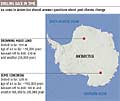|
Climatologists give waterworld warning for Earth
23rd April 2003
New Scientist
As the world gets warmer, it is getting wetter. And one of the main conclusions reached at Europe's largest ever earth sciences conference was that we are less prepared for it than ever.
While some delegates were still reeling from the catastrophic floods that hit the continent in August 2002, others warned that the risk of future flooding has been vastly underestimated. And studies of past episodes of climate change suggest that a wetter world may be not only a consequence of global warming but a trigger for further, more dramatic temperature rises.
The first task was to take stock, in a session devoted to analysing last summer's floods. Most agreed the event was a freak of nature - an unfortunate and unpredictable convergence of events. A cyclone disappeared and then reappeared over central Europe, taking everyone by surprise.
It was followed a couple of days later by a second more powerful cyclone that was halted by a region of high pressure, causing it to dump its huge load of rain over a relatively small area. "It was like a perfect storm," says Jirí Stehlík from Prague's Czech Hydrometeorological Institute.
The floods hit hardest in the Czech Republic, where 15 people died and 220,000 were evacuated. In Prague a flood this severe would normally be expected only once every 500 years; in the south of the country it was a once-in-1000-year event, and some areas received half their expected annual rainfall in just four days.
Freak of nature or not, the disaster was an ominous warning of the kind of events likely to be triggered as global temperatures rise. And they could happen more often than we thought, according to Richard Betts from Britain's Hadley Centre for Climate Prediction and Research in Berkshire. He warned colleagues at the meeting that they have been underestimating the risk of future flooding.
Current models of how climate change will affect average rainfall only take account of the ability of air to hold more water as it gets warmer. This means there will be more evaporation in a warmer world, and therefore more rainfall. This alone would increase river flows worldwide by about one per cent by 2100, making rivers more likely to burst their banks.
But that picture ignores the effects of greenhouse gases on plants, Betts pointed out. In response to high levels of carbon dioxide, plants shrink their stomata - the holes in the surface of their leaves through which gases pass in and out. This drastically reduces water loss from the plants, leaving more water in the soil.
When Betts included these changes in his models of groundwater levels, he found the effect could increase groundwater by 10 per cent over the next century - 10 times as much as global warming alone. A region of central Africa covering part of the Democratic Republic of Congo was one of the worst-affected locations, with soils in the area dealing with an extra six centimetres of water a year.
When wetlands ruled the world
Delegates in sessions devoted to past episodes of climate change also talked about the implications of rising rainfall - and whether it could be a trigger for rapid warming, not just a consequence. One of the liveliest debates concerned the most dramatic changes in the Earth's climate: steep jumps in temperature that can occur in a matter of decades as ice ages draw to a close. Understanding how and why these swings happened is critical to working out whether we are now at risk of triggering something similar.
One popular explanation is that slight initial temperature changes cause a sudden release of vast amounts of the greenhouse gas methane held frozen beneath the seabed in a form known as a gas hydrate. But Mark Maslin from University College London shook things up by suggesting that wetlands were to blame - at least for the most recent rapid warming event, after the last ice age about 18,000 years ago.
His theory came about as a way to settle an argument between oceanographers and land-based palaeontologists. From computer models of plant growth, land-based researchers calculate that about 1000 gigatonnes of carbon has been added to land since the last ice age. This all comes from CO2 in the sea, transferred via the atmosphere.
But oceanographers looking at marine sediments reckon only 500 gigatonnes of carbon has been lost from the ocean. They work this out by measuring the relative amounts of carbon-12 and carbon-13 isotopes in the water over time. Plants preferentially use carbon-12, so the more carbon they take up, the higher the proportion of carbon-13 left in the sea.
Maslin says this overlooks the fact that a blast of methane hydrate would add a dose of carbon-12 to the water. So the ocean could have lost more carbon-13 to the land than previously realised. He calculates that the release of 120 gigatonnes of methane hydrate would reconcile the oceanographers' and palaeontologists' results.
But that is only one-third of the amount of methane that ice cores dating from the time show flooded the atmosphere. So hydrates cannot have been the main cause of the warming: most of the methane must have come from somewhere else, says Maslin. He points to marshes and wetlands as the most likely source, as bacteria in these swamps are a major source of methane.
If an initial nudge in climate made the world wetter, that could have extended wetlands and triggered further, rapid warming. There is separate evidence that the amount of water flowing from the Amazon wetlands nearly doubled during this period, he points out.
Frozen in time
Teams drilling deep into Antarctic ice are working hard to resolve
the question. While marine sediments show roughly how global
temperatures changed in the past, the gases trapped in bubbles in
ncient ice reveal the make-up of the atmosphere, and will help reveal
what caused the changes.
|
